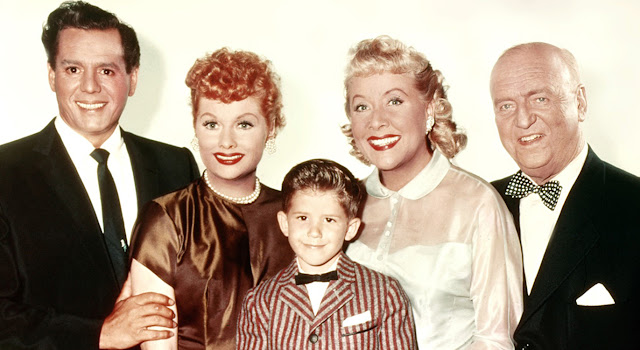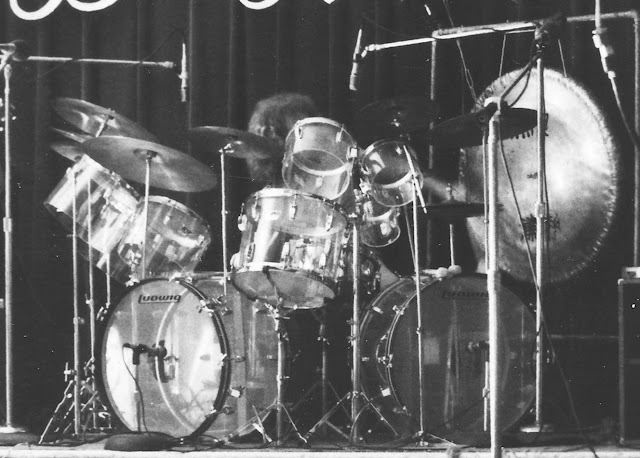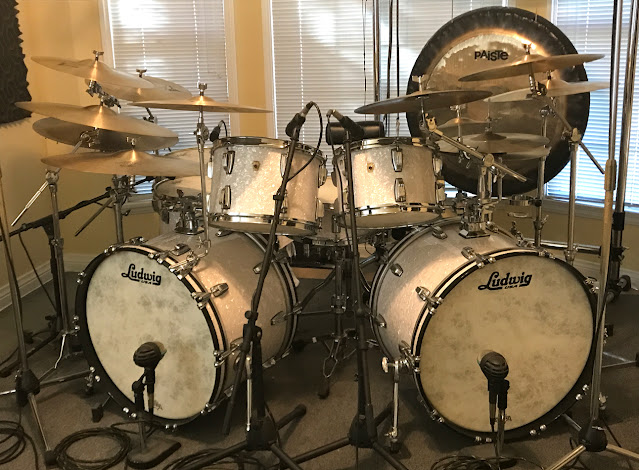Blame it All on Little Ricky: How I Became A Drummer
When I was eight, most of my neighborhood friends had formed
a Cub Scout den, and like any red-blooded eight-year old American boy, I didn’t
want to be left out, so I had my folks sign me up. Although dressing up in the
uniform was fun (we got to wear them to school on the days of our den meetings)
and I enjoyed the boisterous den and pack meetings, ultimately I turned out to
be poor scouting material because I was an overly-cautious kid (read: a chicken
shit). And photographic evidence has subsequently revealed that I looked
incredibly dorky in my blue Cub Scout uniform with the yellow neckerchief. (To
be fair, the uniform didn’t make me look dorky, it’s just that at eight-years
old I was an inherently dorky kid in desperate need of the orthodontia that was
soon to come my way.) I only made it as far as a Bear Scout, with an arrowhead
or two underneath. (I don't remember what the arrowheads meant, but I do remember
that having only a couple meant that I didn’t advance very far).
One time, our scout pack had a big luncheon at the
Sportsmen’s Lodge, a local facility for hire that hosted corporate functions,
weddings, graduation dances and bar-mitzvah parties. The entertainment at the
luncheon was a jazz combo featuring child actor/drummer Keith Thibodeaux, who
played “Little Ricky” on I Love Lucy.
When the curtain opened, there were a few teen-age musicians plus an even younger Thibodeaux, who was seated at a gorgeous sky-blue pearl Gretsch drumset. This was the very first time in my life that I’d ever seen a drumset in person, and I was absolutely mesmerized by it from the moment I first saw it. When the band began to play I was transfixed by the drums — by how they seemed to sparkle under the stage lights, by how Thibodeaux looked as he moved while he played them, but mostly by how they sounded. That SOUND! The whole time the band played the drums popped and rumbled while the cymbals shimmered and pinged. When the music got quiet you could still hear every note the drums were playing, and when the music got loud you could feel the drums in your chest! That afternoon the sound of the drumset came to live inside of me, and it’s been living there ever since.
During intermission a couple of my friends and I went up to the stage and talked with Thibodeaux. (That was another thing that drew me to the drums that day — they were being played by a kid my own age.) When Thibodeaux went to join his bandmates on break we told him that we would “guard his drums”. The other guys quickly lost interest and left, but I stayed and sat on the edge of the stage next to those drums right up until the band came back to play again. It just felt like I belonged near them. When we left the luncheon, everything about those drums, but especially their sound, was still resonating inside me — I was really hooked.
From that day on, whenever I heard music on records or the radio I locked in on the drums. I tried to decipher the music the drums were making. I paid attention to exactly when each drum was being played as part of the song. After a while I felt like I was starting to decode what the drummers were doing: using the bass drum and snare drum to carry the beat and keep the song moving, using cymbals for color and accents, and using tom-toms for short, melodic passages.
A few months later I heard a record on the radio that turned
what I thought I had learned about how drums were played completely
upside-down. On this record the drums weren’t simply keeping the beat and
keeping the song moving. On this record the drums were the song! There was also some surf guitar in there, but it was
the tom-toms that were up front and telling the story. On this record the drums
swung like mad; it was impossible not to tap your foot to them. And to top it
all off, on this record the drums sounded absolutely HUGE! Even through a tiny
AM radio speaker this sounded like the world’s biggest drumset. The record was
called “Let There Be Drums”, and it was recorded by drummer Sandy Nelson and guitarist/producer Richie
Podolor. As one of my Hanukkah presents that year, Mom and Pop took me to the
W.T. Grant store on Van Nuys Boulevard so I could get my very own copy.
 |
My copy of "Let There Be Drums" became just as worn as this one. |
When we got home with the record I asked Pop to play it on
his big hi-fi system. I sat on the floor and listened while it was playing, and
I must have said something about what a great drummer Sandy Nelson was, because
I can remember Mom turning to Pop and saying "Do you think he’s ready for 'Sing, Sing, Sing?'" Pop said "Sure",
and when "Let There Be Drums" was finished he got up and put on his copy of "Sing, Sing,
Sing" from Benny Goodman's Famous 1938
Carnegie Hall Jazz Concert, with Gene Krupa on drums.
 |
The LP that started it all. |
I sat silently on the floor between the speakers, listening in absolute amazement to Krupa’s drumming for the entire thirteen minutes that song played. Krupa’s drumming swung harder than Nelson's, it had more musical twists and turns, and it told a longer, deeper and more involved musical story. And the drums sounded even bigger and more musical. My head began to spin. All I could think was “how on earth is he doing that?”
Gene Krupa, making beautiful music his Slingerland Radio King drums at Carnegie Hall on January 16th 1938. Little did he know how much this would affect a young drummer-to-be some 23 years in the future.
By the time “Sing, Sing, Sing” ended I had decided that I was going to figure out exactly how on earth he did that. At that moment my identity was firmly and irrevocably established as: A Drummer. That is what I had been built to do and it’s what my life has revolved around ever since. It is the thing that has given my life meaning ever since that moment sitting on the floor between the speakers, having my breath taken away by the music Gene Krupa made on his Slingerland Radio King drums back in January of 1938.
After that revelation I began playing “air drums” along with
records and along with whatever was playing on the radio in the house,
imagining that I was sitting behind a typical 4-piece drumset (like the one I had seen Thibodeaux playing) and
playing the drum part on that particular record. This began to deepen my
understanding of how the drumset was played and how the drums fit into the
music. Even though I didn’t have any drums, I was indeed becoming A Drummer.
-Hyam R. Sosnow






Hyam--I totally enjoyed reading your story--I too, fell in love with LTBD and have that record but it was the GUITAR that hooked me--but that's a whole other story---from being in 6th grade class with you and Mrs. Yukelson to finally jamming with you in college (you were the best drummer I had ever played with up till then) I was chasing the guitar dream, but Cream was the band, and yes Ginger spoke to me as well. A poet friend of ours said it was "Ginger's sticks that made all Clapton licks". I agreed. If you have any free time, check out my meager Facebook crap (paintings and music),
ReplyDeleteCrazy Brushstokes Youtube channel--Murphy's Flaw Bluegrass band (I play dobro) and my website garyfriedmanart.com. Stay well, my friend!! Gary
Thanks Gary, I appreciate your kind comments. When I tell the stories of all my bands you'll be in there on guitar and because you played a part in introducing me to the guys I eventually went on the road with. And your paintings on your Facebook wall are absolutely beautiful!
Delete